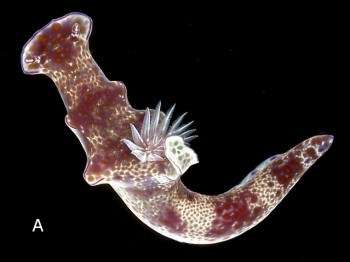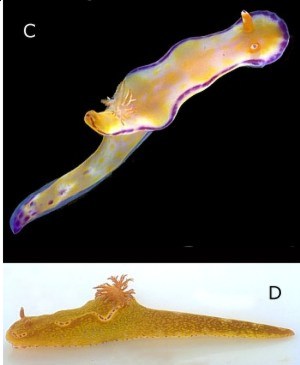
Ceratosoma tenue
Abraham, 1876
Order: NUDIBRANCHIA
Suborder: DORIDINA
Superfamily: EUDORIDOIDEA
Family: Chromodorididae
DISTRIBUTION
Tropical Indo-West Pacific.
PHOTO
A,B. Baie de Koumac, Koumac Region, New Caledonia, 3 m, sandy mud, Caulerpa beds, October 1993, A, 63mm, B, 150mm long alive.
C. juvenile, 20mm long, Coffs Harbour region, northern New South Wales, Australia, December 1990. D. Cymodocea grass beds, Dar es Salaam, Tanzania, February 1974, 68mm long animal with dorsal horn bitten? off. PHOTOS: Bill Rudman.
The two common tropical species of Ceratosoma, C. tenue and C. trilobatum (Gray), are variable in colour, and as both can have very similar colour patterns, considerable confusion has occurred in the past over the identity of specimens. Ceratosoma tenue can be characterised by the three mantle lobes on each side of the body. There is a large anterior lobe on either side of the head and a large lobe on each side by the gills. Between these is a smaller lobe which is joined by a ridge to the gill lobe, but not the head lobe. The edge of the lobes and the ridge joining the posterior lobes is usually outlined with a broken purple line. There is usually no broken purple line between the head lobe and the posterior lobes. Colour variation is very similar to that of C. trilobatum. It does appear that the purple border to the mantle and foot in C. tenue is always a dotted line whereas in C. trilobatum it is usually an unbroken line. Although this species can grow to more than 120mm in length, it is relatively smaller and more elongate than C. trilobatum.
Most species of Ceratosoma have a long recurved dorsal 'horn' which acts as a defensive lure attracting potential predators to the part of the animal which contains most of the distasteful chemicals stored from their food. See Ceratosoma brevicaudatum for photos of its conspicuously marked 'tail', especially in juveniles. This colour 'target' probably also attracts potential predators to the most distasteful part of the animal. See photo below (D) of Ceratosoma tenue from Dar es Salaam, in which whole dorsal horn has been cut off, probably bitten off. although not visible in the photo the animal had a distinct white amputation scar.
References:
•Rudman, W.B. (1984) The Chromodorididae (Opisthobranchia: Mollusca) of the Indo-West Pacific: a review of the genera. Zoological Journal of the Linnean Society 81: 115-273.
•Rudman, W.B. (1988b) The Chromodorididae (Opisthobranchia: Mollusca) of the Indo-West Pacific: the genus Ceratosoma J.E. Gray. Zoological Journal of the Linnean Society 93(2): 133-185.


Rudman, W.B., 1999 (September 29) Ceratosoma tenue Abraham, 1876. [In] Sea Slug Forum. Australian Museum, Sydney. Available from http://www.seaslugforum.net/factsheet/ceratenu
Related messages
-
Re: Ceratosoma tenue from Lembeh - with brittle-star
From: Teresa Zuberbühler, June 6, 2008 -
Ceratosoma tenue from Lembeh - feeding?
From: Kamal El Tawil, April 2, 2008 -
Ceratosoma tenue from sthn Queensland
From: Gary Cobb, October 12, 2007 -
Ceratosoma tenue feeding [3]
From: Bruce Wilkie, October 11, 2007 -
Ceratosoma tenue feeding [2]
From: Bruce Wilkie, October 11, 2007 -
Ceratosoma tenue feeding [1]
From: Bruce Wilkie, October 11, 2007 -
Ceratosoma tenue feeding? from Lembeh
From: Mike Krampf, July 17, 2007 -
Ceratosoma tenue from Anilao, The Philippines
From: Paul Osmond, April 10, 2007 -
Ceratosoma tenue mating
From: Bruce Wilkie, May 31, 2006 -
Ceratosoma tenue with eggs from Buton Island
From: Linda Ianniello, December 1, 2005 -
Ceratosoma tenue laying eggs
From: Mary Jane Adams, October 26, 2005 -
Ceratosoma tenue from Sth Africa
From: Riaan Marx, February 23, 2004 -
Ceratosoma tenue from Sodwana, Sth Africa
From: Charles Rowe, February 5, 2004 -
Ceratosoma tenue with egg ribbon
From: Danny Van Belle, June 5, 2003 -
Ceratosoma tenue from Sth Korea
From: Dong Bum Koh, May 30, 2003 -
A Ceratosoma convention
From: Danny Van Belle, May 28, 2003 -
Ceratasoma tenue from North Sulawesi
From: Marli Wakeling, October 12, 2002 -
Variation: Ceratosoma tenue
From: Valda Fraser, August 12, 2001 -
Ceratosoma tenue from Southern Mozambique
From: Ian Miller, December 19, 2000 -
Mystery slug from Indonesia
From: Marli Wakeling, October 29, 2000 -
Ceratosoma tenue from South Africa
From: Valda Fraser, November 5, 1999 -
Re: Ceratosoma tenue from South Africa
From: Valda Fraser , November 5, 1999
